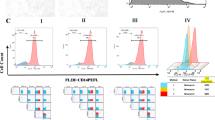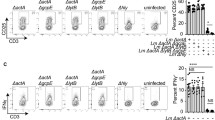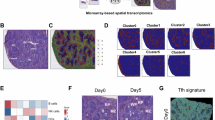Abstract
The acquisition of pathogen-derived antigen by dendritic cells (DCs) is a key event in the generation of cytotoxic CD8+ T cell responses. In mice, the intracellular bacterium Listeria monocytogenes is directed from the blood to splenic CD8α+ DCs. We report that L. monocytogenes rapidly associated with platelets in the bloodstream in a manner dependent on GPIb and complement C3. Platelet association targeted a small but immunologically important portion of L. monocytogenes to splenic CD8α+ DCs, diverting bacteria from swift clearance by other, less immunogenic phagocytes. Thus, an effective balance is established between maintaining sterility of the circulation and induction of antibacterial immunity by DCs. Other Gram-positive bacteria also were rapidly tagged by platelets, revealing a broadly active shuttling mechanism for systemic bacteria.
This is a preview of subscription content, access via your institution
Access options
Subscribe to this journal
Receive 12 print issues and online access
$259.00 per year
only $21.58 per issue
Buy this article
- Purchase on SpringerLink
- Instant access to full article PDF
Prices may be subject to local taxes which are calculated during checkout







Similar content being viewed by others
References
Savina, A. & Amigorena, S. Phagocytosis and antigen presentation in dendritic cells. Immunol. Rev. 219, 143–156 (2007).
van Lookeren Campagne, M., Wiesmann, C. & Brown, E.J. Macrophage complement receptors and pathogen clearance. Cell. Microbiol. 9, 2095–2102 (2007).
Ochsenbein, A.F. et al. Control of early viral and bacterial distribution and disease by natural antibodies. Science 286, 2156–2159 (1999).
Mebius, R.E. & Kraal, G. Structure and function of the spleen. Nat. Rev. Immunol. 5, 606–616 (2005).
Idoyaga, J., Suda, N., Suda, K., Park, C.G. & Steinman, R.M. Antibody to Langerin/CD207 localizes large numbers of CD8α+ dendritic cells to the marginal zone of mouse spleen. Proc. Natl. Acad. Sci. USA 106, 1524–1529 (2009).
Backer, R. et al. Effective collaboration between marginal metallophilic macrophages and CD8+ dendritic cells in the generation of cytotoxic T cells. Proc. Natl. Acad. Sci. USA 107, 216–221 (2010).
Pamer, E.G. Immune responses to Listeria monocytogenes. Nat. Rev. Immunol. 4, 812–823 (2004).
Jung, S. et al. In vivo depletion of CD11c+ dendritic cells abrogates priming of CD8+ T cells by exogenous cell-associated antigens. Immunity 17, 211–220 (2002).
Reinicke, A.T., Omilusik, K.D., Basha, G. & Jefferies, W.A. Dendritic cell cross-priming is essential for immune responses to Listeria monocytogenes. PLoS ONE 4, e7210 (2009).
Zammit, D.J., Cauley, L.S., Pham, Q.M. & Lefrancois, L. Dendritic cells maximize the memory CD8 T cell response to infection. Immunity 22, 561–570 (2005).
Stemberger, C. et al. A single naive CD8+ T cell precursor can develop into diverse effector and memory subsets. Immunity 27, 985–997 (2007).
Belz, G.T., Shortman, K., Bevan, M.J. & Heath, W.R. CD8α+ dendritic cells selectively present MHC class I-restricted noncytolytic viral and intracellular bacterial antigens in vivo. J. Immunol. 175, 196–200 (2005).
Aoshi, T. et al. The cellular niche of Listeria monocytogenes infection changes rapidly in the spleen. Eur. J. Immunol. 39, 417–425 (2009).
Neuenhahn, M. et al. CD8α+ dendritic cells are required for efficient entry of Listeria monocytogenes into the spleen. Immunity 25, 619–630 (2006).
Aichele, P. et al. Macrophages of the splenic marginal zone are essential for trapping of blood-borne particulate antigen but dispensable for induction of specific T cell responses. J. Immunol. 171, 1148–1155 (2003).
Skamene, E. & Chayasirisobhon, W. Enhanced resistance to Listeria monocytogenes in splenectomized mice. Immunology 33, 851–858 (1977).
Neuenhahn, M., Schiemann, M. & Busch, D.H. DCs in mouse models of intracellular bacterial infection. Methods Mol. Biol. 595, 319–329 (2010).
Croize, J., Arvieux, J., Berche, P. & Colomb, M.G. Activation of the human complement alternative pathway by Listeria monocytogenes: evidence for direct binding and proteolysis of the C3 component on bacteria. Infect. Immun. 61, 5134–5139 (1993).
Ford, I. & Douglas, C.W. The role of platelets in infective endocarditis. Platelets 8, 285–294 (1997).
Loughman, A. et al. Roles for fibrinogen, immunoglobulin and complement in platelet activation promoted by Staphylococcus aureus clumping factor A. Mol. Microbiol. 57, 804–818 (2005).
Nguyen, T., Ghebrehiwet, B. & Peerschke, E.I. Staphylococcus aureus protein A recognizes platelet gC1qR/p33: a novel mechanism for staphylococcal interactions with platelets. Infect. Immun. 68, 2061–2068 (2000).
Kleinschnitz, C. et al. Targeting platelets in acute experimental stroke: impact of glycoprotein Ib, VI, and IIb/IIIa blockade on infarct size, functional outcome, and intracranial bleeding. Circulation 115, 2323–2330 (2007).
Kanaji, T., Russell, S. & Ware, J. Amelioration of the macrothrombocytopenia associated with the murine Bernard-Soulier syndrome. Blood 100, 2102–2107 (2002).
Cunnion, K.M., Benjamin, D.K. Jr., Hester, C.G. & Frank, M.M. Role of complement receptors 1 and 2 (CD35 and CD21), C3, C4, and C5 in survival by mice of Staphylococcus aureus bacteremia. J. Lab. Clin. Med. 143, 358–365 (2004).
Wessels, M.R. et al. Studies of group B streptococcal infection in mice deficient in complement component C3 or C4 demonstrate an essential role for complement in both innate and acquired immunity. Proc. Natl. Acad. Sci. USA 92, 11490–11494 (1995).
Hyams, C., Camberlein, E., Cohen, J.M., Bax, K. & Brown, J.S. The Streptococcus pneumoniae capsule inhibits complement activity and neutrophil phagocytosis by multiple mechanisms. Infect. Immun. 78, 704–715 (2010).
Figueroa, J.E. & Densen, P. Infectious diseases associated with complement deficiencies. Clin. Microbiol. Rev. 4, 359–395 (1991).
Drevets, D.A. & Campbell, P.A. Roles of complement and complement receptor type 3 in phagocytosis of Listeria monocytogenes by inflammatory mouse peritoneal macrophages. Infect. Immun. 59, 2645–2652 (1991).
Nakayama, Y. et al. C3 promotes expansion of CD8+ and CD4+ T cells in a Listeria monocytogenes infection. J. Immunol. 183, 2921–2931 (2009).
Gregory, S.H. et al. Complementary adhesion molecules promote neutrophil-Kupffer cell interaction and the elimination of bacteria taken up by the liver. J. Immunol. 168, 308–315 (2002).
Helmy, K.Y. et al. CRIg: a macrophage complement receptor required for phagocytosis of circulating pathogens. Cell 124, 915–927 (2006).
Fitzgerald, J.R., Foster, T.J. & Cox, D. The interaction of bacterial pathogens with platelets. Nat. Rev. Microbiol. 4, 445–457 (2006).
Braun, L., Ghebrehiwet, B. & Cossart, P. gC1q-R/p32, a C1q-binding protein, is a receptor for the InlB invasion protein of Listeria monocytogenes. EMBO J. 19, 1458–1466 (2000).
Ford, I. et al. The role of immunoglobulin G and fibrinogen in platelet aggregation by Streptococcus sanguis. Br. J. Haematol. 97, 737–746 (1997).
Cosgrove, L.J., d'Apice, A.J., Haddad, A., Pedersen, J. & McKenzie, I.F. CR3 receptor on platelets and its role in the prostaglandin metabolic pathway. Immunol. Cell Biol. 65, 453–460 (1987).
Vik, D.P. & Fearon, D.T. Cellular distribution of complement receptor type 4 (CR4): expression on human platelets. J. Immunol. 138, 254–258 (1987).
Kim, D.D. et al. Deficiency of decay-accelerating factor and complement receptor 1-related gene/protein y on murine platelets leads to complement-dependent clearance by the macrophage phagocytic receptor CRIg. Blood 112, 1109–1119 (2008).
Alexander, J.J., Hack, B.K., Cunningham, P.N. & Quigg, R.J. A protein with characteristics of factor H is present on rodent platelets and functions as the immune adherence receptor. J. Biol. Chem. 276, 32129–32135 (2001).
Mollenkopf, H., Dietrich, G. & Kaufmann, S.H. Intracellular bacteria as targets and carriers for vaccination. Biol. Chem. 382, 521–532 (2001).
Heath, W.R. et al. Cross-presentation, dendritic cell subsets, and the generation of immunity to cellular antigens. Immunol. Rev. 199, 9–26 (2004).
Qiu, C.H. et al. Novel subset of CD8α+ dendritic cells localized in the marginal zone is responsible for tolerance to cell-associated antigens. J. Immunol. 182, 4127–4136 (2009).
Botto, M. et al. Homozygous C1q deficiency causes glomerulonephritis associated with multiple apoptotic bodies. Nat. Genet. 19, 56–59 (1998).
Humbles, A.A. et al. A role for the C3a anaphylatoxin receptor in the effector phase of asthma. Nature 406, 998–1001 (2000).
Fischer, M.B. et al. Regulation of the B cell response to T-dependent antigens by classical pathway complement. J. Immunol. 157, 549–556 (1996).
Mombaerts, P. et al. RAG-1-deficient mice have no mature B and T lymphocytes. Cell 68, 869–877 (1992).
Hogquist, K.A. et al. T cell receptor antagonist peptides induce positive selection. Cell 76, 17–27 (1994).
Bahjat, K.S. et al. Cytosolic entry controls CD8+-T-cell potency during bacterial infection. Infect. Immun. 74, 6387–6397 (2006).
Staib, C., Drexler, I. & Sutter, G. Construction and isolation of recombinant MVA. Methods Mol. Biol. 269, 77–100 (2004).
Verschoor, A., Brockman, M.A., Knipe, D.M. & Carroll, M.C. Cutting edge: myeloid complement C3 enhances the humoral response to peripheral viral infection. J. Immunol. 167, 2446–2451 (2001).
Van Rooijen, N. & Sanders, A. Liposome mediated depletion of macrophages: mechanism of action, preparation of liposomes and applications. J. Immunol. Methods 174, 83–93 (1994).
Acknowledgements
We thank S. Gordon, P. Lachmann and H. Wagner for input; M. Botto (Imperial College, London) for C1qa−/− mice; M. Carroll (Harvard Medical School) for C3−/− and C4b−/− mice; C. Gerard (Harvard Medical School) for C3ar−/− mice; F. Petry (Johannes Gutenberg University of Mainz, Germany) for C1qa−/− mice; M. van der Linden (University Hospital Aachen, Germany) for Streptococcus strains; S. Feihl and V. Greifenberg for bacterial typing; L. Henkel, M. Schiemann and K. Wild for flow cytometry cell sorting; K. Mink, S. Vieweg and A. Wanisch for experimental assistance; and L. Layland for support preparing the manuscript. Supported by the German Research Foundation SFB 914 (TP-B4 to A.V. and D.H.B.) and SFB 576 (TP-A8 to D.H.B.), the Swiss National Foundation (3100AO-100779/2 and 3100AO-100068/2 to H.H. and R.M.Z.), the German Center for Infection Research (DZIF; D.H.B.) and the European Commission (Marie Curie Fellowship to A.V.).
Author information
Authors and Affiliations
Contributions
A.V., M.N., A.A.N., A.P., A.S. and P.G. did experiments; B.N. and S.M. supplied reagents and assisted with data interpretation; A.V. and D.H.B. conceived the study; A.V., M.N., A.A.N. and P.G. analyzed the data; A.V., H.H., R.M.Z. and D.H.B. planned the experiments and supervised the study. A.V. and D.H.B. wrote the paper.
Corresponding authors
Ethics declarations
Competing interests
The authors declare no competing financial interests.
Supplementary information
Supplementary Text and Figures
Supplementary Figures 1–2 (PDF 251 kb)
Rights and permissions
About this article
Cite this article
Verschoor, A., Neuenhahn, M., Navarini, A. et al. A platelet-mediated system for shuttling blood-borne bacteria to CD8α+ dendritic cells depends on glycoprotein GPIb and complement C3. Nat Immunol 12, 1194–1201 (2011). https://doi.org/10.1038/ni.2140
Received:
Accepted:
Published:
Issue date:
DOI: https://doi.org/10.1038/ni.2140
This article is cited by
-
The GPIb-IX complex on platelets: insight into its novel physiological functions affecting immune surveillance, hepatic thrombopoietin generation, platelet clearance and its relevance for cancer development and metastasis
Experimental Hematology & Oncology (2022)
-
Interplay between inflammation and thrombosis in cardiovascular pathology
Nature Reviews Cardiology (2021)
-
Patrolling the vascular borders: platelets in immunity to infection and cancer
Nature Reviews Immunology (2019)
-
The inflammatory effects of TNF-α and complement component 3 on coagulation
Scientific Reports (2018)
-
Regulator-dependent mechanisms of C3b processing by factor I allow differentiation of immune responses
Nature Structural & Molecular Biology (2017)



